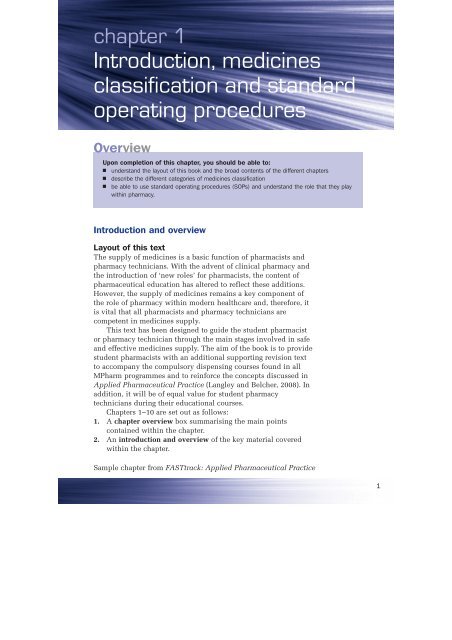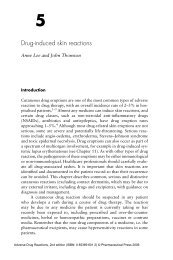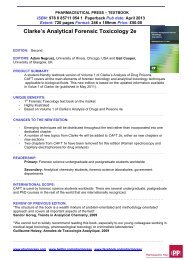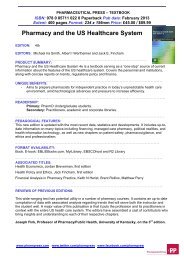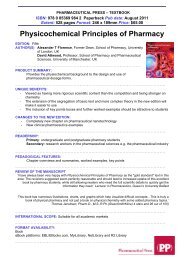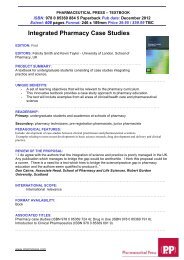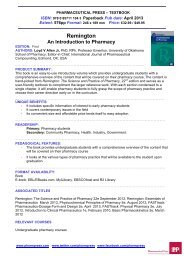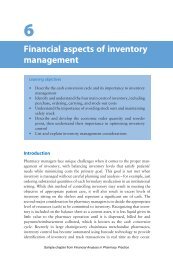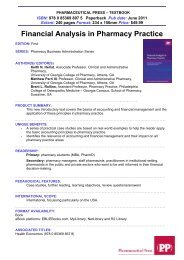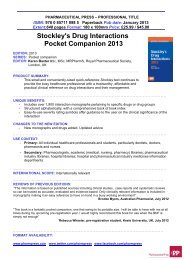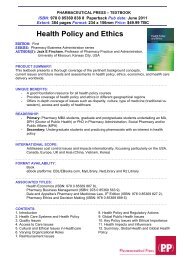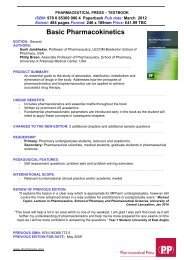Introduction, Medicines Classification And Standard Operating
Introduction, Medicines Classification And Standard Operating
Introduction, Medicines Classification And Standard Operating
You also want an ePaper? Increase the reach of your titles
YUMPU automatically turns print PDFs into web optimized ePapers that Google loves.
chapter 1<br />
<strong>Introduction</strong>, medicines<br />
classification and standard<br />
operating procedures<br />
Overview<br />
Upon completion of this chapter, you should be able to:<br />
■ understand the layout of this book and the broad contents of the different chapters<br />
■ describe the different categories of medicines classification<br />
■ be able to use standard operating procedures (SOPs) and understand the role that they play<br />
within pharmacy.<br />
<strong>Introduction</strong> and overview<br />
Layout of this text<br />
The supply of medicines is a basic function of pharmacists and<br />
pharmacy technicians. With the advent of clinical pharmacy and<br />
the introduction of ‘new roles’ for pharmacists, the content of<br />
pharmaceutical education has altered to reflect these additions.<br />
However, the supply of medicines remains a key component of<br />
the role of pharmacy within modern healthcare and, therefore, it<br />
is vital that all pharmacists and pharmacy technicians are<br />
competent in medicines supply.<br />
This text has been designed to guide the student pharmacist<br />
or pharmacy technician through the main stages involved in safe<br />
and effective medicines supply. The aim of the book is to provide<br />
student pharmacists with an additional supporting revision text<br />
to accompany the compulsory dispensing courses found in all<br />
MPharm programmes and to reinforce the concepts discussed in<br />
Applied Pharmaceutical Practice (Langley and Belcher, 2008). In<br />
addition, it will be of equal value for student pharmacy<br />
technicians during their educational courses.<br />
Chapters 1–10 are set out as follows:<br />
1. A chapter overview box summarising the main points<br />
contained within the chapter.<br />
2. An introduction and overview of the key material covered<br />
within the chapter.<br />
Sample chapter from FASTtrack: Applied Pharmaceutical Practice<br />
1
2 Applied Pharmaceutical Practice<br />
KeyPoint<br />
3. Where appropriate, a collection of worked examples<br />
(Chapters 1–7) to further aid understanding and to include<br />
details on suitable labelling and packaging.<br />
4. A series of self-assessment questions<br />
To gain the most from this text, it is<br />
suggested that the reader has<br />
access to either the print or online<br />
version of a recent copy of both the<br />
British National Formulary and the<br />
respective Drug Tariff for their country<br />
(England and Wales, Northern Ireland<br />
or Scotland).<br />
which it is expected that the student would<br />
work through independently. The answers to<br />
the questions can be found at the end of the<br />
book (in Chapter 11).<br />
To guide the reader through the different<br />
topics relating to medicines supply, this book<br />
has been divided into a number of different<br />
chapters, which reflect the chapters of the<br />
parent volume (Applied Pharmaceutical<br />
Practice) and are as follows.<br />
Chapter 1 <strong>Introduction</strong>, medicinal classification and<br />
SOPs<br />
Chapter 1 introduces the text and provides an outline of the key<br />
points behind medicines supply. It also covers the basic<br />
classification of medicines and the role of standard operating<br />
procedures.<br />
Chapter 2 NHS supply in the community 1: prescription<br />
forms and prescribing<br />
Chapter 2 provides an overview of medicines supply in the<br />
community. NHS prescription forms and the restrictions placed<br />
on different NHS prescribers in the community, including the role<br />
of the UK Drug Tariffs, are covered.<br />
Chapter 3 NHS supply in the community 2: prescribers<br />
and the dispensing process<br />
Chapter 3 discusses the different NHS prescribers within the<br />
community. Following on from this is an overview of the<br />
dispensing process which should be followed when supplying<br />
medicines against NHS prescription forms, along with a<br />
collection of worked examples.<br />
Chapter 4 NHS supply within hospitals<br />
Chapter 4 covers the supply of medicines via the NHS within<br />
hospitals.<br />
Chapter 5 Non-NHS supply<br />
Chapter 5 contains similar material to Chapters 2 and 3,<br />
focusing on non-NHS supply, including the supply of medication<br />
against private prescription forms and via oral and written<br />
requisitions.<br />
Sample chapter from FASTtrack: Applied Pharmaceutical Practice
<strong>Introduction</strong>, medicines classification and SOPs<br />
3<br />
Chapter 6 Controlled drugs<br />
Chapter 6 uses some of the material already discussed in<br />
Chapters 2–5 and summarises the laws and regulations relating<br />
to the supply of controlled drugs, via both NHS and non-NHS<br />
routes.<br />
Chapter 7 Emergency supply<br />
Chapter 7 reinforces the key points behind the emergency supply<br />
of medicines by a pharmacist, at the request of both a prescriber<br />
and a patient.<br />
Chapter 8 Patient counselling and communication 1: the<br />
basics of patient communication<br />
Chapter 8 provides an overview of the basics of patient<br />
communication ensuring that pharmacists and pharmacy<br />
technicians are familiar with both verbal and non-verbal<br />
communication, and able to communicate effectively with<br />
patients and carers.<br />
Chapter 9 Patient counselling and<br />
communication 2: product-specific<br />
counselling points<br />
Chapter 9 summarises important counselling<br />
points that need to be considered for specific<br />
dosage forms, and is a useful reference<br />
source to enable students to answer parts of<br />
the self-assessment questions from other<br />
chapters.<br />
Chapter 10 Poisons and spirits<br />
This chapter discusses the key points behind<br />
the supply of poisons and spirits from<br />
pharmacies.<br />
Chapter 11 Answers to exercises<br />
The final chapter contains answers to the<br />
exercises found in earlier chapters of the<br />
book.<br />
<strong>Medicines</strong> classification<br />
The <strong>Medicines</strong> Act 1968 defines three classes<br />
of medicinal products for human use: general<br />
sale list (GSL) medicines, pharmacy (P)<br />
medicines and prescription-only medicines<br />
(POM).<br />
KeyPoints<br />
This revision text has been designed<br />
to provide student pharmacists and<br />
technicians with a supporting revision<br />
text to accompany the compulsory<br />
dispensing courses found in all<br />
MPharm and technician education<br />
programmes.<br />
To gain the most from this book,<br />
we suggest using the examples<br />
contained within it alongside the<br />
parent volume, Applied<br />
Pharmaceutical Practice (Langley and<br />
Belcher, 2008), which goes into<br />
more detail about the topics<br />
summarised in the chapters in this<br />
text.<br />
KeyPoints<br />
The <strong>Medicines</strong> Act 1968 defines<br />
three classes of medicinal products<br />
for human use:<br />
■ general sale list (GSL) medicines<br />
■ pharmacy (P) medicines<br />
■ prescription-only medicines<br />
(POMs).<br />
Sample chapter from FASTtrack: Applied Pharmaceutical Practice
4 Applied Pharmaceutical Practice<br />
KeyPoints<br />
General sale list medicines<br />
These are medicines that can be purchased from a wide range of<br />
shops, general stores, supermarkets, newsagents, petrol stations,<br />
etc. Products classified as GSL are considered to be reasonably<br />
safe and therefore can be sold without the supervision of a<br />
pharmacist.<br />
Products categorised as GSL medicines have strict controls<br />
concerning their strength, use, pharmaceutical form and route of<br />
administration. The maximum dose or maximum daily dose is<br />
also controlled for medicines for internal use. Another control<br />
that may be enforced is pack size with a limit to the size of pack<br />
allowed as a GSL medicine.<br />
The following classes of medicinal products for human use<br />
are not allowed to be classified as GSL medicines:<br />
■ enemas<br />
■ eye drops<br />
■ eye ointments<br />
■ products containing aspirin or aloxiprin and intended for<br />
administration either wholly or mainly to children<br />
■ products for parenteral administration (a product given by<br />
injection, bypassing the enteral (gastrointestinal) tract)<br />
■ products used as anthelmintics (a substance that expels or<br />
destroys intestinal worms)<br />
■ products used for irrigation of wounds, the bladder, vagina or<br />
rectum.<br />
Pharmacy medicines can be sold only from a pharmacy under the<br />
supervision of a pharmacist. It should be noted that, although the<br />
sale of GSL medicines from a pharmacy does not need to be<br />
under the supervision of a pharmacist, GSL medicines must still<br />
be sold under the ‘personal control’ of a pharmacist.<br />
The term ‘personal control’ comes from<br />
the <strong>Medicines</strong> Act 1968 and has never been<br />
General sale list (GSL) medicines<br />
are medicines that can be purchased<br />
from a wide range of shops, general<br />
stores, supermarkets, newsagents,<br />
petrol stations, etc.<br />
Products classified as GSL are<br />
considered to be reasonably safe and<br />
therefore can be sold without the<br />
supervision of a pharmacist.<br />
interpreted in the courts. However, it is<br />
generally understood to mean that the<br />
pharmacist must be available on the<br />
premises. If a pharmacist is not available, no<br />
medicines (including GSL items) may be sold<br />
at all. For this reason, GSL medicines sold<br />
from pharmacies are often treated as P<br />
medicines. Obviously, this restriction does<br />
not apply to GSL medicines sold from other<br />
(non-pharmacy) establishments.<br />
Pharmacy medicines<br />
These may be sold from pharmacies under the supervision of a<br />
pharmacist. The pharmacist or the pharmacy technician/counter<br />
assistant asks a number of questions before making the sale to<br />
Sample chapter from FASTtrack: Applied Pharmaceutical Practice
<strong>Introduction</strong>, medicines classification and SOPs<br />
5<br />
ensure that the medication is safe for the patient and advice as<br />
to the use of the product is provided. Some medicines may be<br />
sold only when certain criteria have been met, e.g. when<br />
supplying emergency hormonal contraception from a community<br />
pharmacy.<br />
A P medicine is the definition given to medicinal products<br />
not included on the prescription-only medicines order or the<br />
general sale list or is a product that is supplied outside the GSL<br />
package limit or maximum dosage limit. A<br />
few medicines are called pharmacy-only (PO)<br />
medicines and include medicines that would<br />
normally be included on the GSL list but<br />
where the manufacturer has limited the<br />
supply of the medicines to pharmacies only.<br />
Prescription-only medicines<br />
These medicines are usually obtained on the authorisation of a<br />
valid prescription form (either an NHS or a private prescription<br />
form), written by a recognised prescriber registered in the UK and<br />
presented at a registered pharmacy (although exceptions to this<br />
do exist, e.g. dispensing doctors, inpatient hospital supply and<br />
emergency supply at the request of a patient).<br />
Traditionally the prescriber would have been a doctor or a<br />
dentist but, with recent changes to healthcare legislation and the<br />
introduction of supplementary and<br />
independent prescribers, the term ‘prescriber’<br />
includes many other healthcare professionals<br />
such as suitably qualified nurses and<br />
pharmacists.<br />
<strong>Medicines</strong> may also be exempted from<br />
POM classification if there are limitations on<br />
the use of the product. An example would be<br />
hydrocortisone cream 1% normally<br />
categorised as POM, but a P medicine in<br />
packaging that limits the use of the cream to<br />
the treatment of allergic contact dermatitis,<br />
irritant dermatitis, insect bite reactions and<br />
mild-to-moderate eczema; it should be<br />
applied sparingly once or twice a day for a<br />
maximum of 1 week. The P or ‘over-thecounter’<br />
(OTC) form is licensed only for<br />
those indications and dosages, and further<br />
restriction to sales include unsuitability for<br />
OTC sale to treat:<br />
■ children under 10 years<br />
■ conditions on the face or anogenital area<br />
KeyPoint<br />
Pharmacy (P) medicines may be<br />
sold from pharmacies under the<br />
supervision of a pharmacist.<br />
KeyPoints<br />
Prescription-only medicines<br />
(POMs) are medicines that are<br />
described in the Prescription Only<br />
<strong>Medicines</strong> (Human Use) Order 1997.<br />
They are usually obtained on the<br />
authorisation of a valid prescription<br />
form (either an NHS or a private<br />
prescription form) written by a<br />
recognised prescriber registered in<br />
the UK, presented at a registered<br />
pharmacy (although there are<br />
exceptions).<br />
Traditionally the prescriber would<br />
have been a doctor or a dentist but,<br />
with recent changes to healthcare<br />
legislation and the introduction of<br />
supplementary and independent<br />
prescribers, the term ‘prescriber’<br />
includes many other healthcare<br />
professionals such as suitably<br />
qualified nurses and pharmacists.<br />
Sample chapter from FASTtrack: Applied Pharmaceutical Practice
6 Applied Pharmaceutical Practice<br />
KeyPoint<br />
■ conditions where the skin is broken or infected including<br />
cold sores, acne and athlete’s foot<br />
■ pregnant women.<br />
<strong>Medicines</strong> containing controlled drugs are generally given a POM<br />
classification. Exemptions to this general rule include where the<br />
strength of the controlled drug included in the medication is<br />
below a certain value and when the medicine ingredient is<br />
covered by Schedule 5 of the Misuse of Drugs Regulations 2001.<br />
<strong>Standard</strong> operating procedures<br />
<strong>Standard</strong> operating procedures<br />
are often referred to as ‘SOPs’ and<br />
include all the written protocols and<br />
procedures in place within a<br />
pharmacy.<br />
<strong>Standard</strong> operating procedures are often<br />
referred to as ‘SOPs’ and include all the<br />
written protocols and procedures in place<br />
within a pharmacy. They state the way that<br />
the pharmacy expects tasks to be carried out<br />
to ensure provision of a quality service. They<br />
include, for example, the questions that must<br />
be asked of a patient so that his or her needs<br />
can be correctly identified and appropriate<br />
action taken.<br />
The history of SOPs<br />
<strong>Standard</strong> operating procedures, in their current form, have existed<br />
for the dispensing supply process since January 2005. They were<br />
put in place to ensure clinical governance of the dispensing<br />
procedure. ‘Clinical governance’ is the term used in the National<br />
Health Service (NHS) and private healthcare system to describe a<br />
systematic approach to maintaining and improving the quality of<br />
patient care.<br />
As pharmacies differ so much, a single SOP could not be<br />
devised that would cover all pharmacies. Therefore each pharmacy<br />
has individually tailored SOPs for their working environment.<br />
Larger companies, with numerous pharmacies, may have single<br />
SOPs that cover all their premises. These were formerly known as<br />
company policy. It is considered good practice to have SOPs in<br />
place for all procedures carried out in the pharmacy.<br />
What are the advantages of SOPs?<br />
1. They can assist with quality assurance, ensuring that patients<br />
receive a service that meets certain predefined standards.<br />
2. They ensure consistency, which helps to maintain the level of<br />
service offered and therefore maintain good pharmaceutical<br />
practice at all times.<br />
3. They help ‘free time’ for pharmacists, by enabling the<br />
delegation of certain tasks. This in turn enables pharmacists<br />
to engage in some of the ‘new roles’ and provides enhanced<br />
Sample chapter from FASTtrack: Applied Pharmaceutical Practice
<strong>Introduction</strong>, medicines classification and SOPs<br />
7<br />
roles for pharmacy technicians that recognise their specific<br />
expertise.<br />
4. They set out clear lines of accountability, ensuring that staff<br />
are aware of their own responsibilities.<br />
5. They help locum and part-time staff understand the processes<br />
and running of the pharmacy.<br />
6. They are useful templates in the training of new staff.<br />
7. They provide additional information for the audit process.<br />
The preparation of SOPs<br />
The Royal Pharmaceutical Society of Great Britain (RPSGB)<br />
breaks down the preparation of an SOP into six stages:<br />
1. Objectives: the purpose of the SOP.<br />
2. Scope: what are the areas of work to be covered by the SOP?<br />
It is advisable that this should not be over-complex.<br />
3. The stages of the process: this is a description of how the task<br />
is carried out. It is important that this description is clear and<br />
unambiguous, preferably without the use of jargon.<br />
4. Responsibility: who is responsible for carrying out the<br />
procedure and who ensures that staff members are suitably<br />
trained to carry out a procedure? In a working pharmacy this<br />
would also include contingency plans detailing what to do in<br />
cases of sickness or holiday leave, etc.<br />
5. Other useful information: for example, details on how the<br />
SOP is to be audited. Auditing the processes helps maintain<br />
standards and identifies any areas where improvement could<br />
be made.<br />
6. Review: shows how the process is monitored to ensure that it<br />
remains up to date and relevant.<br />
The new pharmacy contract for England and Wales<br />
The new pharmacy contract (since April 2005) divides the<br />
activities that community pharmacies undertake into three tiers<br />
of service: essential services, advanced services and enhanced<br />
services. The essential services provided by a community<br />
pharmacy are compulsory and the minimum required of a<br />
contractor as part of the pharmacy contract.<br />
There are seven essential services identified in the contract:<br />
1. Dispensing<br />
2. Repeat dispensing<br />
3. Disposal of unwanted medicines<br />
4. Promotion of healthy lifestyles (public health)<br />
5. Signposting (provision of information on where and how to<br />
access other healthcare and social care providers)<br />
6. Support for self-care (help to minimise the inappropriate use<br />
of healthcare and social care services)<br />
7. Clinical governance.<br />
Sample chapter from FASTtrack: Applied Pharmaceutical Practice
8 Applied Pharmaceutical Practice<br />
A similar contract exists within Scotland, with four core services:<br />
an acute medication service (AMS), a minor ailment service<br />
(MAS), a chronic medication service (CMS) and a public health<br />
service (PHS). Additional services are to be agreed locally but on<br />
the basis of national (Scottish) specifications.<br />
A pharmacy must have in place SOPs for all these activities.<br />
In addition other SOPs are developed to aid the business, e.g. an<br />
SOP covering OTC sales (sale of medicines and provision of<br />
advice), stock ordering and receipt of goods (ensuring that stock<br />
received is what was ordered, is in date and does not have a short<br />
shelf-life, and is to be stored correctly) and the receipt of<br />
telephone calls, should be in place.<br />
Worked examples<br />
Example 1.1<br />
An SOP for the reception of a prescription form within a<br />
community pharmacy<br />
A summary of how to dispense NHS and non-NHS prescriptions<br />
can be found in the subsequent chapters of this book. However,<br />
Figure 1.1 An example of a standard operating procedure for the reception of a prescription form within a<br />
community pharmacy.<br />
STANDARD OPERATING PROCEDURE – DISPENSING<br />
PRESCRIPTION FORM RECEPTION (NHS)<br />
OBJECTIVES<br />
SCOPE<br />
STAGES OF THE<br />
PROCESS<br />
RESPONSIBILITY<br />
OTHER USEFUL<br />
INFORMATION<br />
REVIEW<br />
To maintain good patient relations<br />
To ensure that the prescription form presented relates to the named patient<br />
To ensure safe dispensing<br />
To ensure that details on the reverse of a prescription form are correctly filled out, and any<br />
applicable fee is collected<br />
To ensure effective communication between patient and pharmacist<br />
The reception of all NHS prescription forms brought into the pharmacy by patients or their<br />
representatives<br />
Prescription forms received in bulk (prescription form collection service) or those received by<br />
telephone call are excluded from this SOP<br />
Greet patient in friendly manner<br />
Check name and address of the patient (rewriting it if handwritten and unclear)<br />
Check that the reverse of the prescription form is filled out correctly<br />
If the prescription form is for a child, check the age or date of birth is specified<br />
Collect any prescription charge(s) and indicate this on the prescription form<br />
Indicate whether or not the patient or patient’s representative is waiting or calling back and<br />
whether or not the patient or patient’s representative has requested to see the pharmacist<br />
Pass the prescription form through to the dispensary for prompt processing<br />
All staff members working on the medicines counter<br />
Audit carried out by pharmacist (or designated technician/supervisor) using the basic<br />
objectives and the stages of the process as a basis of the audit<br />
Following audit, make time to review findings with all staff so that any deficiencies can be<br />
rectified and any points of good practice can be implemented within the whole group, not<br />
just on an individual basis<br />
Sample chapter from FASTtrack: Applied Pharmaceutical Practice
<strong>Introduction</strong>, medicines classification and SOPs<br />
9<br />
consider an SOP for the dispensing of prescriptions (i.e. service<br />
number 1 from the list of essential services above). This can be<br />
broken down into a number of stages:<br />
1. Prescription reception<br />
2. Professional check<br />
3. Intervention and problem solving<br />
4. Label generation and collection of prescription item(s)<br />
5. Accuracy checking<br />
6. Handing out prescription item(s) to patients or their<br />
representatives<br />
7. Dealing with ‘owings’ when prescription forms are<br />
incompletely filled.<br />
The list above covers the basic dispensing procedure and each<br />
stage requires an SOP. Figure 1.1 contains an example of an SOP<br />
for the reception of a prescription form within a community<br />
pharmacy.<br />
Figure 1.2 An example of an audit form for the audit of a standard operating procedure for the<br />
reception of a prescription form within a community pharmacy.<br />
STANDARD OPERATING PROCEDURE – DISPENSING<br />
PRESCRIPTION FORM RECEPTION (NHS) – Audit<br />
NAME OF AUDITOR: _________________________________________________DATE OF AUDIT: ____________________<br />
AUDIT QUESTION<br />
1. Are patients/representatives<br />
greeted in a friendly manner?<br />
2. Is the identity of the patient<br />
checked (i.e. name and<br />
address)?<br />
3. Is the reverse side of the<br />
prescription form checked<br />
for signatures and completion?<br />
4. Is any applicable fee<br />
collected and noted on the<br />
prescription form?<br />
5. If the prescription form is<br />
for a child, is the age or<br />
date of birth checked?<br />
6. Is information transferred<br />
between patient and<br />
pharmacist (call back,<br />
waiting, request for advice)?<br />
7. Are prescription forms promptly<br />
passed to the dispensary?<br />
SATISFACTORY AREAS OF NON-<br />
YES NO COMPLIANCE<br />
RECOMMENDATIONS<br />
REVIEW DATE: ________________________ REVIEWED BY: ____________________________________________________<br />
Sample chapter from FASTtrack: Applied Pharmaceutical Practice
10 Applied Pharmaceutical Practice<br />
Example 1.2<br />
An audit form for the audit of an SOP for the reception<br />
of a prescription form within a community pharmacy<br />
In order to ensure that each SOP is being followed properly and<br />
that it is functioning correctly, periodic audits of the processes<br />
covered by SOPs are carried out. Figure 1.2 contains an example<br />
of an audit form for the audit of an SOP for the reception of a<br />
prescription form within a community pharmacy.<br />
Further examples of SOPs can be found in Applied<br />
Pharmaceutical Practice (Langley and Belcher, 2008).<br />
Self-assessment<br />
For questions 1–7 below, ONE or MORE of the<br />
responses/statements is/are correct. Decide which of the<br />
responses/statements is/are correct and then choose:<br />
A If statements 1, 2 and 3 are all correct.<br />
B If statements 1 and 2 are correct and statement 3 is incorrect.<br />
C If statements 2 and 3 are correct and statement 1 is incorrect.<br />
D If statement 1 is correct and statements 2 and 3 are incorrect.<br />
E If statement 3 is correct and statements 1 and 2 are incorrect.<br />
Question 1<br />
1. POMs cannot be sold to members of the general public.<br />
2. PO medicines are GSL medicines where the manufacturer<br />
has limited the supply of the medicines to pharmacies only.<br />
3. P medicines are any medicinal products not included in the<br />
<strong>Medicines</strong> (Products other than Veterinary Drugs) (General<br />
Sale List) Order 1984 or the Prescription Only <strong>Medicines</strong><br />
(Human Use) Order 1997.<br />
Question 2<br />
1. In pharmacies all GSL medicines must be sold under the<br />
supervision of a pharmacist as defined by the <strong>Medicines</strong> Act<br />
1968.<br />
2. In pharmacies all PO medicines must be sold under the<br />
supervision of a pharmacist as defined by the <strong>Medicines</strong> Act<br />
1968.<br />
3. In pharmacies all GSL medicines must be sold under the<br />
personal control of a pharmacist as defined by the <strong>Medicines</strong><br />
Act 1968.<br />
Question 3<br />
With the exception of some controlled drugs, when prescribing a<br />
medical practitioner may do the following:<br />
1. Prescribe any GSL medicine within its product licence.<br />
Sample chapter from FASTtrack: Applied Pharmaceutical Practice
<strong>Introduction</strong>, medicines classification and SOPs<br />
11<br />
2. Prescribe any P medicine within its product licence.<br />
3. Prescribe any POM medicine within its product licence.<br />
Question 4<br />
Which of the following are classes of medicinal products for<br />
human use as defined by the <strong>Medicines</strong> Act 1968?<br />
1. POM – prescription-only medicine<br />
2. GSL – general sale list medicine<br />
3. PO – pharmacy-only medicine<br />
Question 5<br />
Which of the following types of medicinal product for human use<br />
CANNOT be included in the general sale list (GSL) even though<br />
the substances that they contain may be contained in the list?<br />
1. Products for use as mouthwashes<br />
2. Products for use as eye ointments<br />
3. Products for use for irrigation of wounds<br />
Question 6<br />
Which of the following items would not be allowed to be<br />
classified as a GSL medicine?<br />
1. Ovex – a tablet for the treatment of threadworms<br />
2. Opticrom – an eyedrop used to alleviate the symptoms of<br />
hayfever<br />
3. Anusol suppositories – used to treat haemorrhoids<br />
Question 7<br />
Which of the following statements concerning SOPs is true?<br />
1. Originally designed to ensure clinical governance of the<br />
dispensing procedure.<br />
2. An SOP for the dispensing procedure would be the same for<br />
every community pharmacy in a particular primary care<br />
trust.<br />
3. An SOP for the dispensing procedure would NOT be<br />
required in hospital pharmacy because they are covered by<br />
Crown immunity.<br />
Question 8<br />
Which ONE of the following is NOT one of the seven essential<br />
services as identified by the new pharmacy contract?<br />
A Dispensing<br />
B Counter prescribing<br />
C Disposal of unwanted medicines<br />
D Signposting<br />
E Promotion of healthy lifestyle<br />
Sample chapter from FASTtrack: Applied Pharmaceutical Practice
12 Applied Pharmaceutical Practice<br />
Question 9<br />
Paracetamol may be a GSL, P or POM medicinal product. Which<br />
ONE of the following could NOT be considered a GSL medicine<br />
under any circumstances?<br />
A 16 paracetamol effervescent tablets 500 mg<br />
B 30 paracetamol effervescent tablets 120 mg<br />
C 100 paracetamol effervescent tablets 500 mg<br />
D 32 paracetamol tablets 500 mg<br />
E 100 paracetamol tablets 500 mg<br />
Question 10<br />
Regarding the sale of naproxen as a pharmacy (P) medicine,<br />
which ONE of the following statements is true?<br />
A It can be sold for use in patients aged between 12 and 50.<br />
B Packs must NOT contain more than 5 days’ supply.<br />
C The maximum daily dose is 1000 mg.<br />
D The maximum single dose is 500 mg.<br />
E It is indicated for the treatment of musculoskeletal pain and<br />
inflammation.<br />
Question 11<br />
Regarding the sale of hydrocortisone for external use as a GSL<br />
medicine, which ONE of the following statements is true?<br />
A A tube of ointment with a maximum strength of 1% would be<br />
suitable for a GSL sale.<br />
B The size of the tube of ointment or cream sold as a GSL<br />
medicine is 15 g.<br />
C It is indicated to treat reactions to insect bites and stings.<br />
D Its use is restricted to adults and children aged over 12<br />
years.<br />
E Maximum length of treatment is 7 days.<br />
Question 12<br />
Regarding the classification of medicines which ONE of the<br />
following statements is true?<br />
A There is a definitive list of P medicines.<br />
B It is not a legal requirement for 64 paracetamol tablets to be<br />
sold by, or under the supervision of, a pharmacist.<br />
C Hypromellose eyedrops BPC (artificial tears) may be sold<br />
while the pharmacist is out at lunch.<br />
D A P medicine may be sold from any supermarket where a<br />
pharmacist is present to supervise the sale.<br />
E All homeopathic preparations that have a certificate of<br />
registration can be sold as if they had been given GSL status.<br />
Sample chapter from FASTtrack: Applied Pharmaceutical Practice
<strong>Introduction</strong>, medicines classification and SOPs<br />
13<br />
Summary<br />
This chapter has introduced the text and explained the contents<br />
of the subsequent chapters. In addition, basic medicines<br />
classification has been described, where medicines are classified<br />
into three categories: GSL medicines, P medicines and POMs.<br />
Finally, the purpose and construction of SOPs have been covered.<br />
It is important that student pharmacists and pharmacy<br />
technicians understand the points covered in this chapter and<br />
attempt the questions at the end of the chapter before moving on<br />
to any subsequent parts of the book.<br />
Sample chapter from FASTtrack: Applied Pharmaceutical Practice


